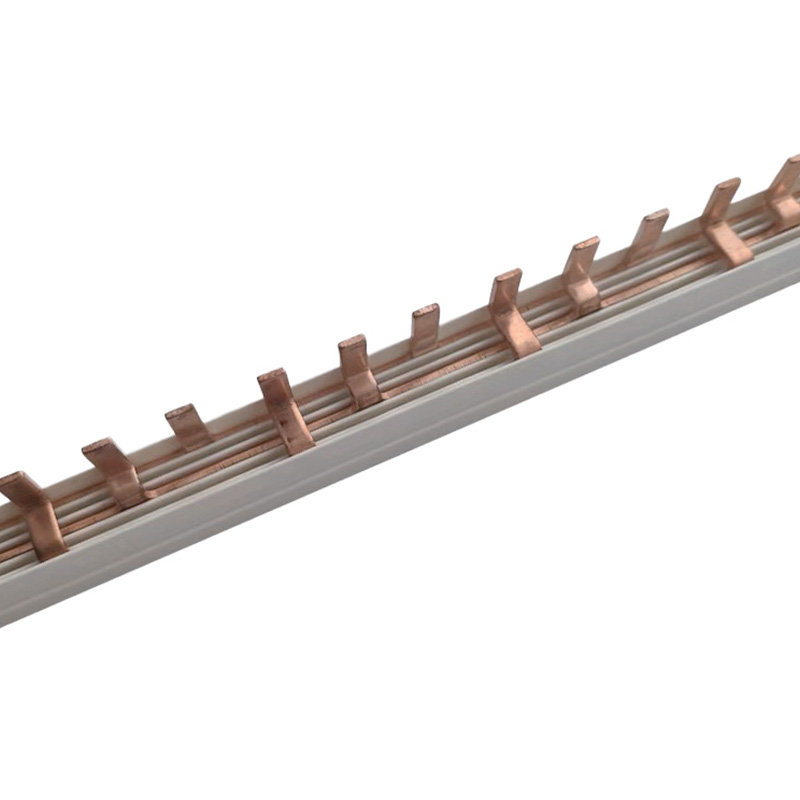Understanding and selecting the correct IP rating is essential when choosing a Waterproof Junction Box or Waterproof Distribution Box. It ensures safety, reliability, and long-term...
READ MORE-
-
Outdoor electrical installations face unique challenges that require specialized components to ensure their reliability and safety. Among the more important components are metal ca...
READ MORE -
Durability is a key factor when designing and maintaining electrical systems. With so many environmental challenges that electrical installations face—such as excessive temperature...
READ MORE -
Safety compliance is not just about adhering to regulations; it’s about protecting people, equipment, and infrastructure from the risks of electrical hazards. Electrical fires, sho...
READ MORE
What Are the Characteristics of the Pin-Type MCB Busbar?
Pin-type MCB busbars are key components in electrical distribution systems, ensuring stable and reliable current flow across multiple miniature circuit breakers (MCBs). They are designed for modular, compact installations and are widely used in residential, commercial, and industrial panels.
1. Structural Design
Pin-type busbars feature multiple conductive pins that directly connect to MCB terminals. This design allows for quick and secure insertion, reducing installation time. The pins are precisely spaced to match standard MCB layouts, ensuring proper alignment and electrical continuity.
2. Material Composition
These busbars are typically made of high-conductivity copper or copper alloys, often with a tin or nickel plating to prevent oxidation and corrosion. The conductive material ensures low resistance, voltage drop and energy loss in the circuit. Insulating covers or barriers are often added to prevent accidental contact and maintain safety.
3. Electrical Performance
Pin-type busbars are designed to handle rated currents of individual MCBs while maintaining uniform current distribution across all poles. They reduce the likelihood of overheating and electrical faults due to loose connections. Their rigid structure also provides stability under vibration or minor mechanical stress, making them suitable for both indoor and industrial environments.
4. Installation and Maintenance Benefits
The pin-type design simplifies installation by allowing tool-free connection to MCBs. Maintenance is also easier, as individual breakers can be replaced without dismantling the entire busbar system. This modular approach enhances flexibility and reduces downtime during system upgrades or repairs.
Pin-type MCB busbars offer structural precision, conductivity, reliable electrical performance, and practical installation advantages, making them essential components in modern distribution boards.
What Colors Are Available for the Circuit Breaker Copper Busbar?
Circuit breaker copper busbars are often color-coded to simplify installation, improve safety, and ensure compliance with wiring standards. Color-coding helps electricians quickly identify different phases, neutral connections, and grounding paths.
Standard Phase Colors
In three-phase electrical systems, busbars are usually color-coded to represent each phase. Commonly used colors include red, yellow, and blue, corresponding to phases L1, L2, and L3. This color differentiation reduces the risk of incorrect wiring and simplifies troubleshooting during maintenance.
Neutral and Ground Colors
The neutral busbar is often designated by blue or black, while grounding busbars are marked green or green-yellow. This ensures that neutral and protective earth connections are easily distinguishable from live phases, preventing potential short circuits or safety hazards.
Custom Color Options
Some manufacturers offer copper busbars with additional colors for specialized applications or client requirements. This flexibility is useful in complex electrical panels, where multiple circuits must be easily identifiable. Custom colors also help integrate busbars into industrial or commercial environments with specific labeling standards or safety codes.
Safety and Compliance
Color-coded busbars help maintain compliance with international and regional electrical standards, such as IEC, NEC, or local wiring codes. Proper color usage reduces installation errors, enhances operational safety, and improves the efficiency of inspection and maintenance tasks.
Circuit breaker copper busbars are available in standard phase colors (red, yellow, blue), neutral and grounding colors (blue, green, green-yellow), and customizable options to meet installation and safety requirements.
How Do I Choose a Pin Type 3 Pole for an MCB Busbar?
Choosing a pin-type 3-pole busbar for an MCB involves several key considerations to ensure compatibility, reliability, and safety in the electrical distribution system.
1. Rated Current and Voltage Compatibility
Select a busbar that matches the rated current and voltage of the MCBs being used. The busbar must handle the cumulative load without overheating or causing voltage drops. Check the manufacturer’s specifications for current-carrying capacity and ensure it meets or exceeds the total load requirements.
2. Pole Alignment and Spacing
Pin-type 3-pole busbars must align with the physical layout of the MCBs. Confirm the spacing between pins corresponds to the terminal arrangement of the breakers. Proper alignment ensures secure connections, minimizes electrical resistance, and allows for easy installation or replacement of individual breakers.
3. Material and Plating
Select a busbar made of high-conductivity copper or copper alloy, preferably with tin or nickel plating for corrosion resistance. The material affects both electrical performance and longevity. High-quality plating reduces oxidation and maintains consistent contact over time, ensuring reliable operation even in industrial environments.
4. Safety and Insulation
Ensure the busbar includes appropriate insulation or protective covers to prevent accidental contact. Some busbars feature modular insulating barriers between poles for added safety. Additionally, consider compliance with IEC, UL, or local electrical standards to guarantee safe and legal installation.
5. Flexibility and Maintenance
Choose a design that allows easy installation and maintenance. Modular pin-type busbars simplify replacement of individual MCBs, reducing downtime and labor costs. Consider future expansion or upgrades when selecting the busbar.
By considering rated current, alignment, material, insulation, and maintenance flexibility, users can select the appropriate pin-type 3-pole busbar to ensure safe, efficient, and reliable distribution in any electrical system.


 English
English 中文简体
中文简体 Español
Español عربى
عربى










